Irrigation-Advisor—A Decision Support System for Irrigation of Vegetable Crops
Water 2019, 11(11), 2245; https://doi.org/10.3390/w11112245
Partner Publication (CSIC):
1 Centro de Edafología y Biología Aplicada del Segura (CEBAS), Consejo Superior de Investigaciones Científicas (CSIC), Espinardo, 30100 Murcia, Spain
2 Escuela Técnica Superior de Ingeniería Agronómica, Universidad Politécnica de Cartagena, Paseo Alfonso XIII 48, 30203 Cartagena, Spain
3 Instituto Valenciano de Investigaciones Agrarias (IVIA), Centro Desarrollo Agricultura Sostenible (CEDAS), Unidad asociada al CSIC “Riego en la agricultura mediterránea”, Apartado Oficial, 46113 Moncada, Valencia, Spain
Abstract:
Climate change will intensify water scarcity, and therefore irrigation must be adapted to save water. Operational tools that provide watering recommendations to end-users are needed. This work presents a new tool, Irrigation-Advisor (IA), which is based on weather forecasts and is able to separately determine soil evaporation and crop transpiration, and thus is adaptable to a broad range of agricultural situations. By calculating several statistical indicators, IA was tested against the FAO-56 crop evapotranspiration (ETcFAO) methodology using local crop coefficients. Additionally, IA recommendations were compared with current standard practices by experienced farmers (F). Six field experiments with four widely cultivated species (endive, lettuce, muskmelon and potato) were performed in Southeast Spain. Irrigation water applied, crop yield, aboveground biomass and water productivity were determined. Crop water needs underestimations (5%–20%) were detected when comparing IA against ETcFAO, although the index of agreement proved reasonable adjustments. The IA recommendations led to water savings up to 13% when compared to F, except for lettuce, with a 31% surplus in irrigation when using IA. Crop yield was not compromised and water productivity was increased by IA. Therefore, IA mimicked the farmers′ irrigation strategies fairly well without deploying sensors on-site. Nevertheless, improvements are needed for increasing the accuracy of IA estimations.


0 comments